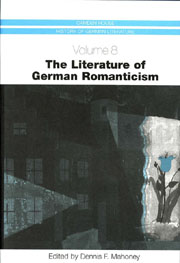Book contents
- Frontmatter
- Contents
- Illustrations
- Acknowledgments
- Abbreviations
- Introduction
- From “Romantick” To “Romantic”: The Genesis of German Romanticism in Late Eighteenth-Century Europe
- Goethe and the Romantic
- Early Romanticism
- From Goethe's Wilhelm Meister to anti-Meister Novels: The Romantic Novel between Tieck's William Lovell and Hoffmann's Kater Murr
- Tales of Wonder and Terror: Short Prose of the German Romantics
- The Romantic Drama: Tieck, Brentano, Arnim, Fouqué, and Eichendorff
- German Romantic Poetry in Theory and Practice: The Schlegel Brothers, Schelling, Tieck, Novalis, Eichendorff, Brentano, and Heine
- The Turn to History and the Volk: Brentano, Arnim, and the Grimm Brothers
- History and Moral Imperatives: The Contradictions of Political Romanticism
- Romanticism and Natural Science
- Gender Studies and Romanticism
- The Romantic Preoccupation with Musical Meaning
- Romanticism and the Visual Arts
- Goethe's Late Verse
- The Reception of German Romanticism in the Twentieth Century
- Works Cited
- Notes on the Contributors
- Index
The Romantic Drama: Tieck, Brentano, Arnim, Fouqué, and Eichendorff
Published online by Cambridge University Press: 05 February 2013
- Frontmatter
- Contents
- Illustrations
- Acknowledgments
- Abbreviations
- Introduction
- From “Romantick” To “Romantic”: The Genesis of German Romanticism in Late Eighteenth-Century Europe
- Goethe and the Romantic
- Early Romanticism
- From Goethe's Wilhelm Meister to anti-Meister Novels: The Romantic Novel between Tieck's William Lovell and Hoffmann's Kater Murr
- Tales of Wonder and Terror: Short Prose of the German Romantics
- The Romantic Drama: Tieck, Brentano, Arnim, Fouqué, and Eichendorff
- German Romantic Poetry in Theory and Practice: The Schlegel Brothers, Schelling, Tieck, Novalis, Eichendorff, Brentano, and Heine
- The Turn to History and the Volk: Brentano, Arnim, and the Grimm Brothers
- History and Moral Imperatives: The Contradictions of Political Romanticism
- Romanticism and Natural Science
- Gender Studies and Romanticism
- The Romantic Preoccupation with Musical Meaning
- Romanticism and the Visual Arts
- Goethe's Late Verse
- The Reception of German Romanticism in the Twentieth Century
- Works Cited
- Notes on the Contributors
- Index
Summary
In 1802, August Wilhelm Schlegel had little positive to report about the repertoire and the condition of the contemporary German stage. In his view, it consisted mainly of poor translations or revisions of Italian, French, and English material. The audience preferred so-called “Familiengemälde” (family tableaux), which combined the action, characters, and problem areas of the bourgeois tragedy and sentimental comedy, and trivialized them in a moralizing stereotypical manner. Also popular was the “Ritterdramatik” (knightly drama), which also adapted the pattern of the bourgeois melodrama and embellished it with pseudo-historical details, mostly of medieval character.
While the entertainment drama, with its emphasis on illusion, dealt with current topics taken from the contemporary bourgeois environment, new tendencies to rehabilitate historic and mythological materials, which had been among the preferred subject areas in the neo-classicist theater of the early Enlightenment (especially Johann Christoph Gottsched, 1700–1766), can be observed in the last two decades of the eighteenth century. Even though this choice had been explained with normative reasons around 1700, as the genus sublime (elevated genre) of tragedy required contents related to the state, new poetological principles come to bear around 1800 that allow us to roughly divide the dramaturgical and dramatic development emerging at that time into two directions. On one hand, the Weimar classics (Schiller, Goethe) claim a “modern drama,” which adapts the traditions of antiquity and transforms them, thereby turning the dramatized individual case into a symbol for all humankind.
- Type
- Chapter
- Information
- The Literature of German Romanticism , pp. 125 - 146Publisher: Boydell & BrewerPrint publication year: 2003

